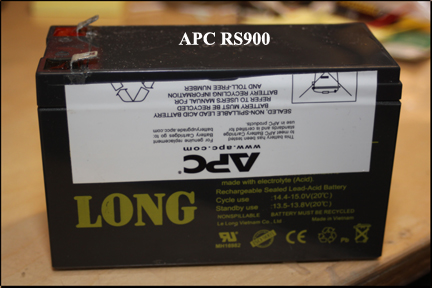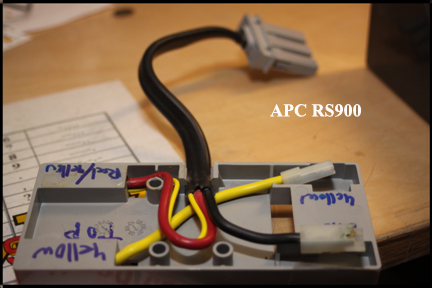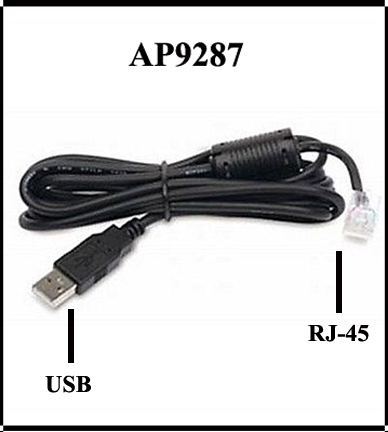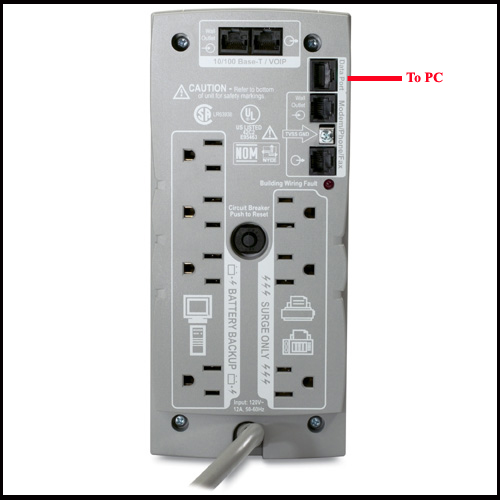Ron Stultz
"APC RS 900 UPS - Overview"

Summary: if you are going to buy an APC RS900, spend the extra money to get one with a new battery pack installed, has an APC USB to RJ-45 cable and one that is guaranteed by the seller. The RS900 will not power on the first time without an operational battery pack and so you could spend $40 or more on a battery pack to learn that the RS900 is not functional. And without an APC USB to RJ-45 cable you will not be able to setup and properly test the RS900.
Background:
APC is a well known supplier of uninterruptable power supplies (UPS).
APC UPS's are robust in design and execution meaning that they use high quality, heavy duty components and wire, in their products.
The APC RS 900, also known as (AKA) BR 900, was introduced to the home market in 2004 (copyright on user manual).
The APC RS 900/BR 900 is not longer sold new from APC. The recommended replacement is the BR1000G.
APC must have sold a lot of these units into the home/office marketplace as there are many used units on eBay and elsewhere.
The APC RS900 provides 4 battery-backup supported outlets and 3 surge protected outlets. It also provides surge protection of an Ethernet line.
The APC RS900 has a power reset button on the back panel that you can use to reset internal electronics should the RS900 experience an overload condition. This button is simply pressed in and released.
The APC RS 900 uses (2) 12volts direct current (VDC), 7200 milliamp hour (Mah) batteries. The size (dimensions) of these batteries are standard in that you can buy replacement batteries from a variety of sources to include Home Depot, eBay, etc.
You can replace the 7200 Mah batteries with those that claim to have larger Mah's.
The APC RS 900 uses the (2) 12VDC batteries in a 24VDC configuration and you must have the APC battery hookup harness to properly connect batteries to the RS 900.
Note: the APC RS900 will not turn on for the first time if: a battery pack is not installed or the battery pack is not charged.
Note: the APC RS900 does not support an external or additional battery pack like more expensive APC UPS units do.
Once the APC RS900 has turned on and is fully operational, a hot swap of the battery pack can be done, meaning you do not have to turn off the APC to install a new battery pack.
The APC RS900 has programmable features but to access and change these, you must have the APC USB to RJ-45 signal cable, connect cable to a personal computer (PC) and install APC's free software. There is no way around this process as only by using APC's PowerChute software can you properly set up and test the RS900.
The APC RS900 I bought was not bought to support a PC but rather a cable television (CATV) cable amplifier. Even still, I had to use PowerChute software and the signal cable to setup and test initially.





Standard operation:
With a fully charged battery pack installed, and the RS900 plugged into a wall outlet, when you push in the power button at the top of the unit:
- The power or "on-line" button will begin to blink.
- After a moment, you will hear a relay click and the next light down or the "on-battery" light will come on and stay lit for a short period time.
- The "on battery" light should then go out and the power button or "on-line" green light at the top should stop blinking and stay lt.
- If any other light comes on and stays on, such as "overload" or "replace battery", you should unplug any load on the battery-back outlets and try cycling the unit again.
- If the "replace battery" light comes on and stays on, you need shut down the RS900, unplug from the wall, remove battery pack and test each battery individually.
The sequence of lights signify a RS900 self test at start up.
As reported else where, a RS900 passing an initial start up self test does not confirm 100% that it is charging the battery pack correctly. The only way to confirm charging is to connect the unit to a PC via the signal cable and run Powerchute software.
Buy a used APC RS900 or buy a new UPS from a retailer?
The APC RS 900 has a decent volt-amp (VA) support capacity although no UPS of this physical size is going to support a desktop for very long.
Any UPS that you can buy cheaply is more for getting you through momentary power outages than running your system for extended periods of time.
APC does make a superior product to many others in the market.
The APC RS900 sold for $300 or more new and is reflected in its quality components.
There is no warranty from APC on RS900 and they don't even service these units anymore.
On one hand, you get a better constructed unit with higher capacity for a price less than new units but on the other hand, all electronics age and eventually fail.
If you are looking for a plug-in and forget it UPS, buy a new one off-the-shelf.